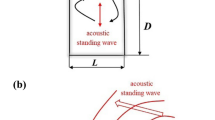Abstract
The pulse water jet pump is widely used for many industrial purposes owing to the presence of pressure fluctuations that can considerably improve the erosive action of a jet. However, literature regarding the cavitating water jet flow patterns and underlaying mass transfer mechanisms remains relatively scarce due to existing measurement obstacles. To reveal underlying relationships between pump geometrical configuration and its performance, this study presents an experimental and numerical investigation of a self-excited oscillation water jet pump. Firstly, an experimental rig was built, and the performance of the pump was assessed against various operating conditions. Then, a numerical model based on the same pump geometry and operation conditions was developed to provide detailed predictions of the internal cavitating flow patterns. Reasonably good agreements were found between the numerical predictions and experimental measurements, which indicate that the developed numerical model can accurately predict the flow entrainment process in the self-excited oscillation pulse jet pump. Internal cavitating flow patterns in terms of streamlines, pressure contours, and velocity profiles were explored for different pump geometric configurations by adjusting the nozzle-throat distance. Relationships between these influential factors and pump mixing capacity were provided. This paper presents an in-depth understanding of the self-excited oscillation pulse water jet and systematically explores the impacts of pump geometries and operating conditions on its performance.
Similar content being viewed by others
Change history
05 February 2022
A Correction to this paper has been published: https://doi.org/10.1007/s42757-022-0132-z
References
Chen, J., Havtun, H., Palm, B. 2014. Parametric analysis of ejector working characteristics in the refrigeration system. Appl Therm Eng, 69: 130–142.
Deng, X., Dong, J., Wang, Z., Tu, J. 2017. Numerical analysis of an annular water-air jet pump with self-induced oscillation mixing chamber. J Comput Multiphase Flow, 9: 47–53.
Folkes, J. 2009. Waterjet—An innovative tool for manufacturing. J Mater Process Technol, 209: 6181–6189.
Gosline, J. E. 1934. The Water Jet Pump. University of California Press.
Kim, Y. K., Lee, D. Y., Kim, H. D., Ahn, J. H., Kim, K. C. 2012. An experimental and numerical study on hydrodynamic characteristics of horizontal annular type water-air ejector. J Mech Sci Technol, 26: 2773–2781.
King, J. L., Boyle, P., Ogle, J. B. 1958. Instability in slotted wall tunnels. J Fluid Mech, 4: 283–305.
Li, D., Kang, Y., Ding, X., Wang, X., Fang, Z. 2016. An experimental investigation on the pressure characteristics of high speed selfresonating pulsed waterjets influenced by feeding pipe diameter. J Mech Sci Technol, 30: 4997–5007.
Liu, C., Liu, G., Yan, Z. 2019. Study on cleaning effect of different water flows on the pulsed cavitating jet nozzle. Shock Vib, 2019, Article ID: 1496594.
Liu, C., Liu, G., Zhang, W. 2018. Influence of pulse period on amount of ejection fluid in jet pump. Joumal of Nanjing University of Science and Technology, 5: 609–614.
Mazzelli, F., Little, A. B., Garimella, S., Bartosiewicz, Y. 2015. Computational and experimental analysis of supersonic air ejector: Turbulence modeling and assessment of 3D effects. Int J Heat Fluid Fl, 56: 305–316.
Pereira, P. R., Varga, S., Soares, J., Oliveira, A. C., Lopes, A. M., de Almeida, F. G., Carneiro, J. F. 2014. Experimental results with a variable geometry ejector using R600a as working fluid. Int J Refrig, 46: 77–85.
Strušnik, D., Marčič, M., Golob, M., Hribernik, A., Živić, M., Avsec, J. 2016. Energy efficiency analysis of steam ejector and electric vacuum pump for a turbine condenser air extraction system based on supervised machine learning modelling. Appl Energ, 173: 386–405.
Vijay, M. M., Hu, S. G., Remisz, J. 1993. A study of the practicality of cavitating water jets. International Journal of Surface Mining, R eclamation and Environment, 7: 137–147.
Wang, X., Dong, J., Li, A., Lei, H., Tu, J. 2014. Numerical study of primary steam superheating effects on steam ejector flow and its pumping performance. Energy, 78: 205–211.
Zhu, Y., Cai, W., Wen, C., Li, Y. 2007. Shock circle model for ejector performance evaluation. Energ Convers Manage, 48: 2533–2541.
Acknowledgements
This research is financially supported by the Scientific Opening Research Platform of Chongqing Industrial and Commercial University (Project ID: fykf201906), and Chongqing Basic Research and Frontier Exploration Project (Project ID: cstc2019jcyj-msxm2000).
Author information
Authors and Affiliations
Corresponding author
Rights and permissions
About this article
Cite this article
Deng, X., Dong, J. Experimental and numerical investigation of two-phase flow and mass transfer in a self-excited oscillation pulse jet pump. Exp. Comput. Multiph. Flow 3, 131–136 (2021). https://doi.org/10.1007/s42757-020-0062-6
Received:
Revised:
Accepted:
Published:
Issue Date:
DOI: https://doi.org/10.1007/s42757-020-0062-6



